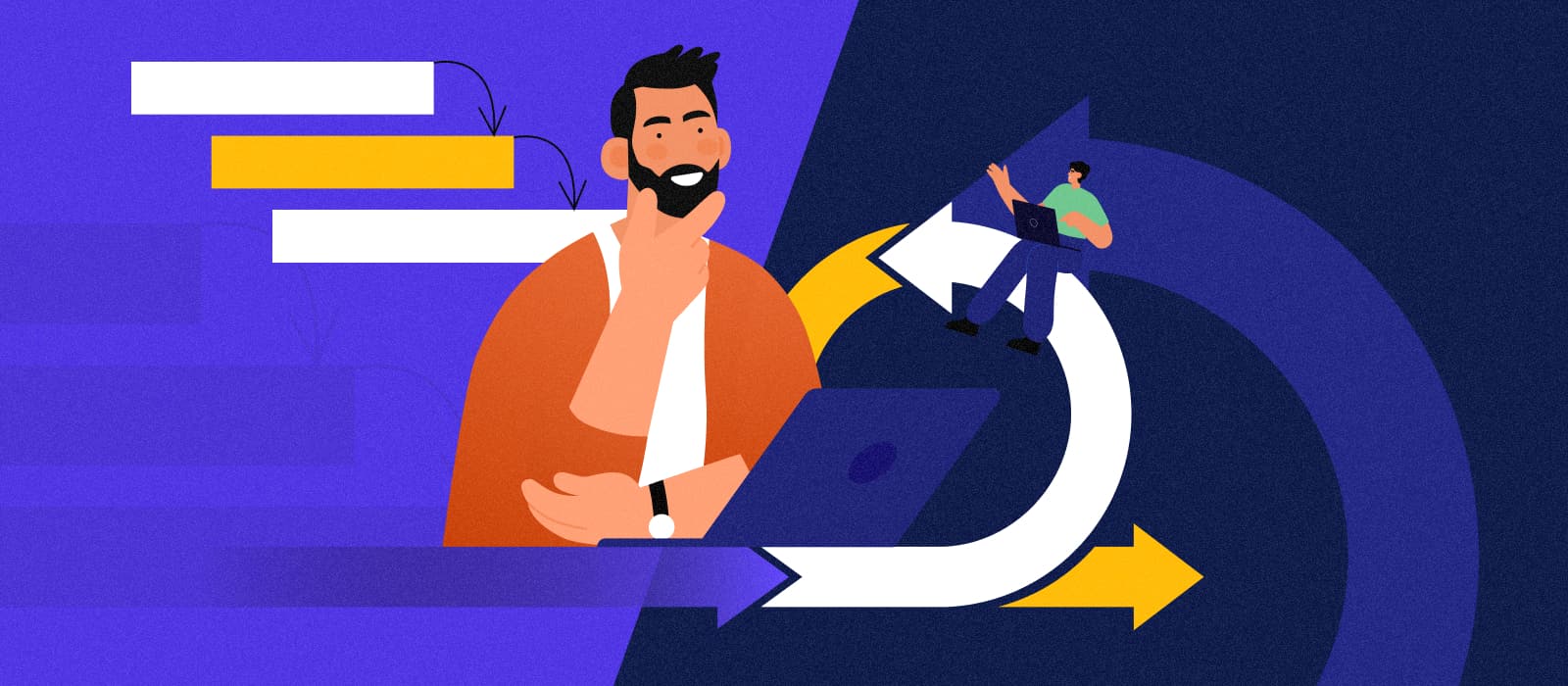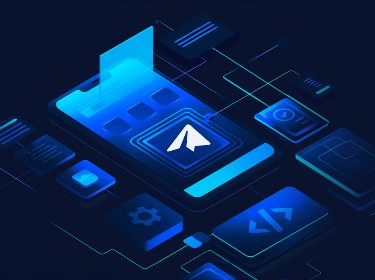Batman or Superman? Agile or Waterfall? Two eternal questions people spend hours arguing about. We are not experts in superheroes but we can help you define which of the two leading software development methodologies is best for your project.
Waterfall and Agile are the most popular development approaches to date. According to surveys, 71% of companies choose Agile while Waterfall is implemented by 51% of organizations.
Arguments about which approach is the best have been sparking for years, causing heated debates. Yet software development teams often forget that the question is not about which approach is always the best, but rather which one works most effectively for a certain project.
With this article we will try to stop the Agile vs Waterfall confrontation and show the main features that make these methodologies so popular. In addition, we will identify the downsides you should take into consideration when choosing which approach to follow.
What should you know about software development methodologies?
A software development methodology describes certain patterns and disciplines applied while working on a software project. Developers can choose from a wide variety of methodologies, each coming with its own set of peculiarities. However, there is no one-size-fits-all approach, so it is important to choose the one that will best contribute to your project’s progress.
Adhering to a certain approach makes the entire development process more efficient and smooth, with all team members knowing their responsibilities and deadlines. It also helps the team leader to navigate through the project easily and distribute the tasks appropriately without delays and overtime.
Meanwhile, a wrong software development methodology can significantly hinder the progress of your project or even result in its failure. The list of possible problems range from high risks of miscommunication within the team and with the client to broken deadlines and flawed products.
In this article, our custom software development company will help you understand the flow of different development methodologies, especially the two most popular ones.
Overview of the Waterfall methodology
![]()
Waterfall is a traditional linear software development methodology with each consequent stage starting only when the previous one is complete. This approach is very strict and is not responsive to changes.
Well-managed and detailed documentation is one of Waterfall’s pillars and each aspect of the future product is discussed and written down before the process begins. As the full scope of work is defined in advance, progress is easily tracked and measured.
A Waterfall team comprises four roles: developer, tester, business analyst, and project manager. Clients and stakeholders are not involved much, participating in the initial planning stage and reviews only.
What are the stages of Waterfall development?
A Waterfall-driven software development process includes the following stages:
- Requirements gathering and documentation preparation
First comes the definition of the project’s design and functions, its challenges and purpose. At this stage, the team documents all the specifications while the UI/UX design services experts work on deciding the core design components.
- System design
When all features have been discussed and determined, the project’s architecture and UI/UX patterns go into production.
- Development
During the development phase, all work is divided into units that are built in chain order until all components are gathered in the final solution.
- Testing
When the developers have finished writing code, a software testing company joins the game. Their task is to check whether there are any faults, bugs or security flaws. When the testers find something, the code is directed to developers for correction.
- Delivery
Once development and testing is complete, the product is ready to be released to the public.
- Maintenance
After delivery, the product can be modified and altered based on the client’s requirements, according to users’ reviews, or if something does not work as expected.
Ever wondered how software is tested? Read our article to find out all the details
Key pros and cons of the Waterfall approach
The Waterfall methodology gains its major plus points due to the following features:
- Well-defined development plan
- Comprehensive documentation
- Clearly-defined requirements
- Settled budget
However, everything comes with its downsides. The Waterfall methodology lacks:
- Flexibility
- Speed of development
- Client engagement
- Autonomy (delays or bugs in one unit affect all other units)
Introducing the Agile methodology
![]()
The Agile software methodology has appeared in response to growing demand for a more flexible and faster development approach. In contrast to the sequential Waterfall method, the Agile approach is receptive to changes and implements them straight off. The same goes with fixing bugs.
The Agile workflow is divided into 1 to 4-week sprints with weekly sprint reviews where team members share their results and make plans for the next sprint. The team also processes customer feedback to be ready to implement possible alterations and make sure everything meets the client’s desires.
Documentation is not so important in Agile, with the main emphasis being placed on software performance.
A standard Agile team includes the Product Owner, team leader (Scrum Master), programmers, testers and data engineers.
The role of Product Owner is a unique one and denotes an intermediary between the client and the team. The Product Owner is the one responsible for the success of the project. To achieve it they should maintain effective client-team communication and make sure that each party understands what they should do.
What are Agile frameworks?
The Agile methodology has multiple frameworks: Scrum, Kanban, Extreme programming, Feature driven software development, Behavior driven development, Crystal, and Dynamic Systems Delivery. This article would be too long if we described all of them, so let’s focus on the three most widely-used — Scrum, Extreme programming and Kanban.
Scrum development is all about speed. Scrum sprints last for approximately 2 weeks and result in a variation of the final product that is shown to the client.
Extreme programming (XP), in its turn, aims to deliver the solution even faster. XP teams practice test-driven development (TDD) meaning that the automated unit tests are written even before the code itself.
Meanwhile Kanban heavily relies on visualization and utilizes a special tool called a Kanban board. This is a table that can be physical or digital and consists of several columns: Backlog, In progress, Testing and Done. The tasks move from column to column, clearly indicating the project’s progress.
Take a look at Savage — an NFT marketplace we built leveraging the Kanban framework
What are the stages of Agile development?
Software development with the Agile approach is determined by the following steps:
- Concept
The Product Owner delivers to the team the key project requirements such as features and desired end results. The timeframes and budget are also estimated at this stage.
- Iteration 1
Once the team gets all the details, the development process begins. First, a mock-up of the user interface and the project architecture is built.
- Testing and review
The client reviews the developed functionality and suggests alterations or additions. Also, testers check whether there are any bugs.
- Iteration 2
This stage is when alterations and bug fixes are attended to. The next elements of the product also go into production.
The iteration-testing-review cycle is repeated multiple times until the solution becomes a fully-fledged product and the client is satisfied with the outcome.
- Release
Once the QA team states the solution works smoothly with no bugs and security concerns, it is ready to be released.
- Maintenance
To ensure flawless functioning of the solution, the team provides post-release support. They also perform iterations to upgrade the existing product.
Key advantages and disadvantages of the Agile approach
Agile wouldn’t have become one of the most effective methodologies if it didn’t offer considerable advantages. Let’s have a look at the benefits Agile brings to the development process:
- Well-established communication
- Flexibility
- Fast detection of bugs
- Fast product delivery
Yet there are also some disadvantages that can affect the development:
- Unclear outcome and timeframes
- Underdeveloped documentation
- Excessive communication
- High dependence on the client’s involvement
Is there a hybrid approach?
Sure, because why choose one development approach when you can take the best of both? This is exactly what hybrid methodology is about — mixing Agile and Waterfall together to make a blend that corresponds exactly to the needs of a particular project.
For example, with a hybrid approach, developers don’t need to wait for one phase to finish to proceed to the next one as is done with Waterfall. Instead, the next phase begins as soon as possible. This results in independent development of components and modules of the project — one of the key Agile features. Yet, the distinctive Waterfall traits are also present — the documentation can still be well-maintained and tight deadlines met.
Projects that leverage a hybrid Agile+Waterfall approach enjoy reduced project costs, enhanced development speed and well-managed documentation.
At PixelPlex we often use the hybrid methodology. One such example is our Green Hypermarket project. Combining practices from Waterfall and Agile, we managed to complete the development cycle in just 8 weeks and released a fully functional enterprise mobile app development project.
We followed Waterfall’s tenet of clarifying all the requirements and establishing a clear roadmap before production begins, and added a pinch of Agile with intense team collaboration and boosted development speed.
Learn about other software development methodologies in our article
When to use Agile vs Waterfall: key factors to consider
![]()
Depending on the specific features of your project, implementing it with Agile may be more suitable, or it might thrive with the Waterfall approach. To make sure you go for the most beneficial software methodology, we recommend you carefully analyze the following factors:
- Clarity of requirements — if the requirements are precise and are very unlikely to change, then Waterfall is a good choice. But if the concept is vague and could undergo multiple alterations, it will definitely work better with Agile.
- Depth of client involvement — Agile is perfect when the client shows genuine interest in the development process. On the contrary, it is Waterfall where the client is not involved in the development much.
- Project type — Agile works perfectly for highly complex solutions while Waterfall is a better option for more straightforward projects and for delivering enhancements to existing products.
- Time constraint — Waterfall is all about fixed deadlines but when the time frames are not so strict you may opt for Agile.
- Budget limits — the same principle as with the timeline: if the budget is tight then Waterfall is most suitable, while Agile works better with an unlimited or big budget.
- Intensity of team collaboration — Agile heavily emphasizes the role of communication within the team, with sprint reviews being organized regularly. Meanwhile, with the Waterfall approach developers can work more independently, each being responsible for their part of the project.
Conclusion
There are a lot of options when it comes to software development methodologies, but it is for good reasons that the Waterfall and Agile methodologies are widely considered the most effective.
Both methodologies have significant advantages, the most important being Agile’s flexibility and Waterfall’s stability. Thus, when choosing a development approach, make sure you clearly understand the requirements of the project so that the chosen workflow secures successful software development.
With 15 years of experience in software development we’ve tried multiple methodologies and learnt to identify which suits the project best. Drop us a line and we will help you decide on the proper development strategy for your project.




